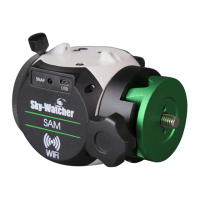connecon to create much longer exposures – like a minute or two – or
ten! With a suciently long exposure, your camera will collect enough
light to reveal hidden details that are much too faint for our eyes to see.
But then, quite literally, you’ll see the second problem!
The Need For Tracking
In your now, nicely exposed photo, the stars don’t look like stars anymore
– they look like lile lines and arcs of variable lengths! The problem here
is called trailing, and it becomes more noceable as the focal length of
your lens and/or your exposure me increases.
You might think that trailing is due to the movement of the stars, but
it’s not. It’s due to the movement of your camera as it records those
distant stars over the course of that exposure. Your camera is moving
because it is sing on a tripod that is sing on the Earth, and the Earth
is rotang. This moon causes the stars, which appear to be xed in
space from our perspecve, to appear to move relave to us, and more
importantly, to our camera.
SAM overcomes this challenge by moving your camera to precisely
oset the eects of Earth’s rotaon while a suciently long exposure
of the night sky is being made. SAM’s tracking capability keeps a specic
area of the sky impinging upon the same part of the camera sensor
throughout the exposure. So a star will fall on the same set of pixels
from the beginning through the end of the exposure. The result is a
well-exposed photo of the night sky with pin point star images.
With SAM, two of the biggest challenges in doing astrophotography
are simplied and automated for you. SAM’s camera control features
enable you to take exposures in excess of 30s each. SAM’s tracking
ability keeps your camera on target to produce pin point star images.
As your skill level in astrophotography progresses you can set SAM up
to take mulple images of your subject, then use advanced processing
techniques like stacking to make truly remarkable celesal portraits.
An equatorial mount rotates
to prevent star trailing in
your photo by precisely
countering Earth’s Rotaon.
17

